Bathroom renovations
Bathroom Tile Ideas For Your Next Renovation
Bathroom Tile Ideas & Inspiration for Your Next Renovation
Bathroom tiles can add a unique touch to any bathroom space. There are countless bathroom tile ideas to choose from, ranging from classic and timeless to modern and trendy.
One of the most important factors to consider when choosing bathroom tiles is the material. Porcelain, ceramic, marble, and glass are just a few of the popular options available. Each material has its own unique properties and benefits, such as durability, water resistance, and easy maintenance. It’s essential to choose a material that not only looks great but also meets the practical needs of the bathroom.
Another key consideration when choosing bathroom tiles is the material. Options such as marble, cement, ceramic, porcelain, faux wood, and glass each provide a unique look and offer specific benefits. Glass tiles, for example, reflect light and create a bright and open feel, while cement tiles offer a modern, industrial aesthetic. Considering the individual qualities of each material will ensure your design not only looks stunning but also stands the test of time.
Choosing the Right Bathroom Tile
Consider the Size of Your Bathroom
When selecting bathroom tiles, it’s important to consider the size of your bathroom. Smaller bathrooms may benefit from larger-format tiles, which create fewer grout lines and give the appearance of a more spacious area. On the other hand, larger bathrooms can accommodate a wider variety of tile sizes and patterns, allowing for more creative designs.
What Kind of Tile is Best for a Small Bathroom?
For small bathrooms, consider using light-coloured tiles to create a more open and airy feel. Also, consider using wood-look porcelain or ceramic tiles, which offer the beauty of wood and the durability of tile. Moreover, large-format wall tiles can provide a chic, minimal design that can help make a small bathroom feel larger.
Think About Your Style and Preferences
Your bathroom tile should reflect your personal style and preferences. There are many options available, such as:
- Glass tiles: An opulent touch, resistant to stains, mould, and mildew, and easy to clean.
- Encaustic cement tiles: Durable, waterproof and resistant to germs and bacteria.
- Natural stone tiles: Can add a touch of luxury and sophistication to your bathroom.
Consider the Maintenance Required
Different tile materials require different levels of maintenance. For example:
- Porcelain and ceramic tiles: Easy to clean and require little maintenance.
- Natural stone tiles: More porous and may require sealing to prevent water damage.
- Glass tiles: Resistant to stains, mould, and mildew but may show fingerprints and watermarks.
Overall, it’s essential to choose a bathroom tile that not only fits your style but also suits the size of your bathroom and requires a level of maintenance you’re comfortable with.
Types of Bathroom Tiles
When considering bathroom tile options, it’s important to understand the various materials available. In this section, we will discuss three popular types of bathroom tiles: Ceramic, Porcelain, and Stone.
Ceramic
Ceramic tiles are a popular choice for bathrooms due to their versatility and durability. They are made from clay that has been fired at high temperatures to create a strong, resilient surface. With a wide range of colours, styles, and finishes available, ceramic tiles can elegantly suit any bathroom design.
- Easy Maintenance: Ceramic tiles are water-resistant and can be easily cleaned with household cleaning products.
- Affordable: Ceramic tiles typically cost less than porcelain and stone tiles, making them an attractive choice for budget-conscious homeowners.
- Design Options: From simple, classic designs to more intricate patterns, ceramic tiles offer countless aesthetic options to enhance the overall look of a bathroom.
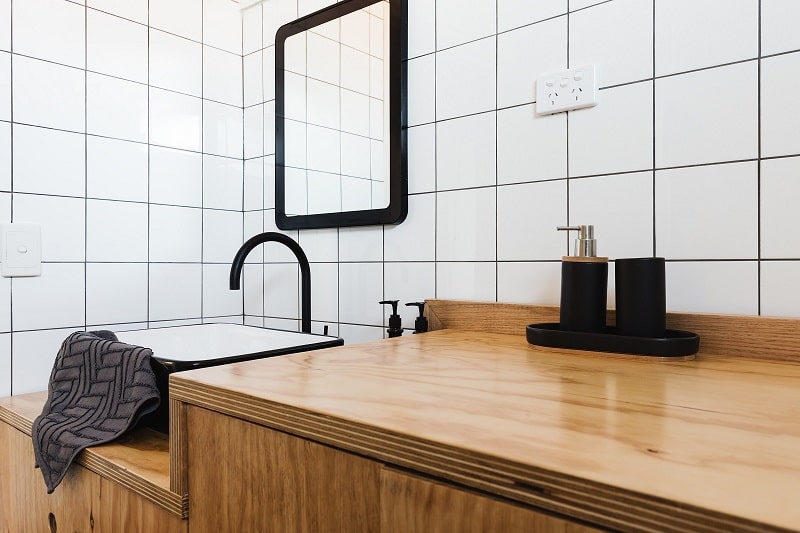
Porcelain
Porcelain tiles offer a more refined and elegant appearance, making them ideal for those seeking a luxurious finish for their bathroom. These tiles are manufactured from fine-grained clay and fired at higher temperatures than ceramic, resulting in an even stronger and more durable tile.
- Low Water Absorption: Porcelain tiles are less porous than ceramic tiles, making them more water-resistant and an excellent choice for wet areas like showers and baths.
- Hard-wearing: Thanks to their dense structure and durability, porcelain tiles are resistant to scratches and stains, which makes them ideal for high-traffic areas.
- Variety: Porcelain tiles are available in a range of styles, including wood-look, stone-look, and even metal-look, providing homeowners with numerous design options.
Stone
Natural stone tiles, such as marble, granite, and slate, offer a unique and timeless appeal to any bathroom. These tiles are cut from natural rock formations, thus providing an organic and luxurious feel to the bathroom space.
- Distinctive Aesthetic: The natural textures and patterns of stone tiles create an eye-catching and sophisticated appearance in the bathroom environment.
- Durability: Stone tiles are known for their strength and lasting durability, making them a worthwhile investment for those seeking a long-lasting tile solution.
- Variety: There are various types of stone tiles, each with its unique characteristics and colour variations, providing a diverse selection for homeowners to choose from.
By understanding the key features and differences between ceramic, porcelain, and stone tiles, homeowners can make the best decision for their bathroom according to their design preferences and budget constraints.
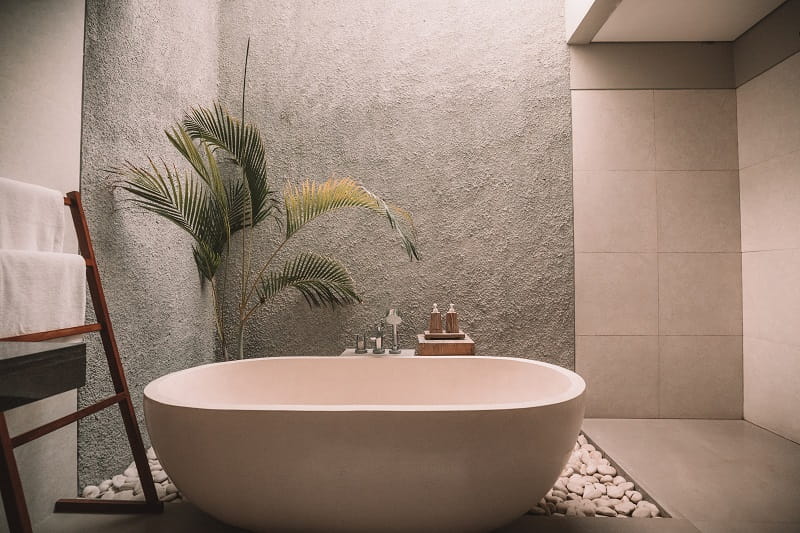
Tile Layout and Patterns
Straight Lay
The straight lay pattern is a simple and common tile layout for bathrooms. In this pattern, tiles are positioned side-by-side in straight rows and columns. The straightforward design makes it easy to install and maintain, perfect for those who prefer a classic and unassuming look. A benefit in the straight lay pattern is that it can make a room appear more spacious, as the eye is drawn along the clean lines created by the tiles.
Grid
The grid pattern is a variation of the straight lay, where tiles are aligned to create a distinctive grid-like appearance. This pattern is achieved by offsetting each row or column of tiles, so that the lines between them appear as a continuous grid. The grid pattern can add visual interest to a bathroom and work well with square or rectangular tiles. Be sure to use grout that complements the tile colour to enhance the overall look.
Herringbone
The herringbone pattern creates a visually striking element in bathroom tile designs. In this pattern, tiles are laid at a 45-degree angle, forming a series of V-shaped configurations. This dynamic layout can be achieved with rectangular tiles, such as subway tiles or wood-look planks, creating a sense of movement and depth in the space. According to The Tile Shop, the herringbone pattern is an eye-catching choice that can enhance any room decor.
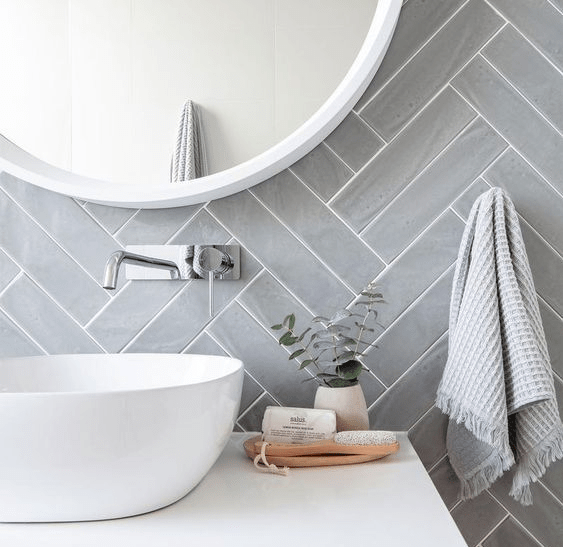
Chevron
The chevron pattern, similar to the herringbone, is created by arranging tiles in a V-shape but with a subtle difference. Instead of rectangular pieces, this pattern requires tiles specially cut at an angle, resulting in continuous lines that form a seamless chevron. This design can make a bathroom feel more stylish and dynamic, adding a bold visual impact to the space. The chevron pattern works well with various tile materials, such as porcelain, ceramic, and natural stone, offering endless possibilities for customization.
Colour and Texture Choices
Bold Colours
Incorporating bold colours into your bathroom tile design can create a striking visual effect. For instance, a combination of black floor tiles, white wall tiles, and shimmery accent tiles can add depth and contrast to the space. Another option is to use a mix of complementary colours, such as deep emerald green and gold. To create an even more unique look, consider a random pattern of sea green, dark blue, and creamy white tiles. This playful approach can make your bathroom feel truly one-of-a-kind.
Neutral Tones
Neutral tones can lend a timeless and elegant look to your bathroom. For example, shades of grey can add interest and warmth without overpowering the space. Marble is another popular choice for achieving a classic, sophisticated appearance. Subway marble tiles, in particular, can exude old-world charm and class.
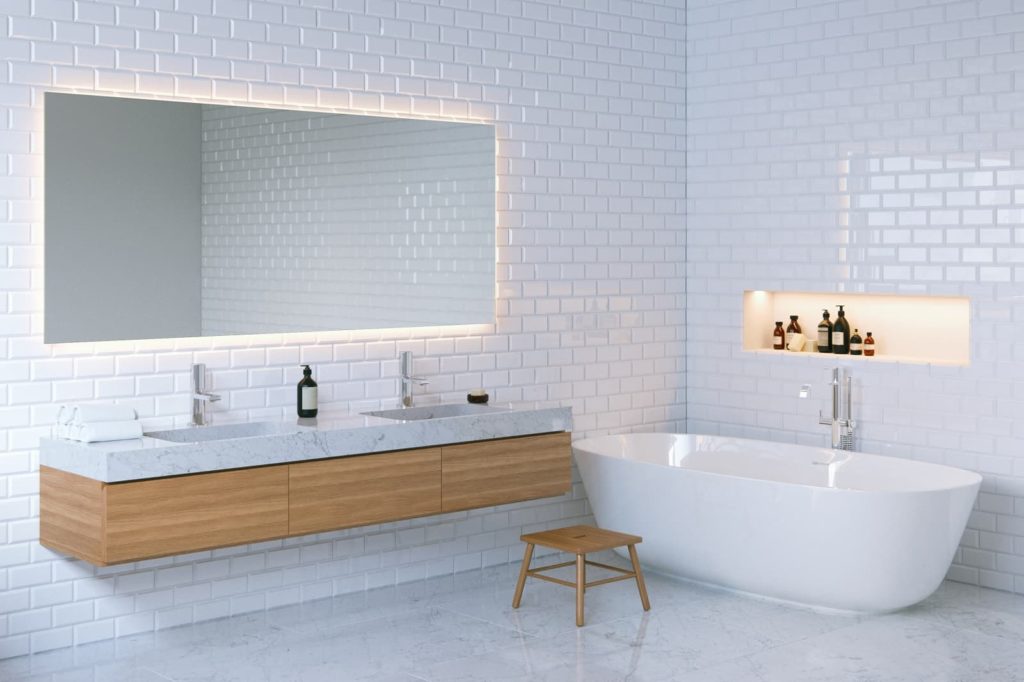
Textured Surfaces
Textured surfaces can add both visual and tactile appeal to your bathroom tile design. One option to consider is zellige tiles, antique clay tiles with a unique light grey colour. Another idea is to combine different shapes or materials within the same colour palette. This approach can create contrast and visual interest while maintaining a harmonious overall appearance.
Tile Size and Scale
When planning a bathroom remodel, considering the tile size and scale is essential to achieving the desired appearance. Different sized tiles can impact the overall look and feel of the space.
Large Format Tiles
Large format tiles, found in various styles including wood-look planks and 3-D tiles, are an excellent choice for a modern and minimalist design. With fewer grout lines, they cover walls more seamlessly, creating a chic and clean aesthetic. These tiles transition well between various design elements, such as contrasting different-sized or coloured tiles.
Adding built-in lighting throughout the design can make large format tiles even more visually appealing.
Small Mosaic Pieces
Small mosaic tiles are ideal for smaller bathrooms, as they can give the illusion of a larger space. Penny tiles, being particularly versatile and timeless, can be used in both small and large bathroom designs. These tiny tiles create intricate patterns, adding an interesting and dynamic visual element to the room. Mosaic tiles can also be combined with other tile sizes or styles for added depth and dimension.
In summary, the choice of tile size and scale significantly impacts the appearance of the bathroom. Large format tiles create a modern and seamless look, while smaller mosaic pieces can add visual interest and make smaller spaces appear larger. Considering the size and scale of tiles during the planning stage of a bathroom remodel will help achieve the desired design outcome.
Combining Materials and Styles
Tile and Wood Combos
One popular way to create a sophisticated and unique bathroom look is by combining different tile styles with wood. This creates an elegant and stunning visual effect that adds warmth to the space. For example, you can use porcelain or ceramic tiles on the walls, and wooden planks on the floor for a luxurious yet natural feel1.
To further enhance the visual appeal, consider combining different types of wood, such as light and dark varieties, with complementing tile colours. This will create an interesting contrast and make your bathroom stand out.
Mixing Tile Patterns
Another creative approach to bathroom design is mixing different tile patterns, shapes, and styles to add immediate intrigue. For instance, you can opt for a daring mosaic tile on the floor and a crisp, white tile wall for a fun contrast. Alternatively, play around with scale by mixing small, hexagonal tiles with large oblong tiles to create a sense of variation.
When choosing tiles for your bathroom, don’t be afraid to experiment with different colours, patterns, and textures. For example, you can use handmade patterned Turkish ceramic tiles on the upper wall to create a striking and practical backsplash behind the sink.
In conclusion, combining different materials and styles in your bathroom can create a truly unique and eye-catching space. Mixing different tile patterns, shapes, textures, and even wood creates a stunning design that embodies your personal taste and adds character to your home.
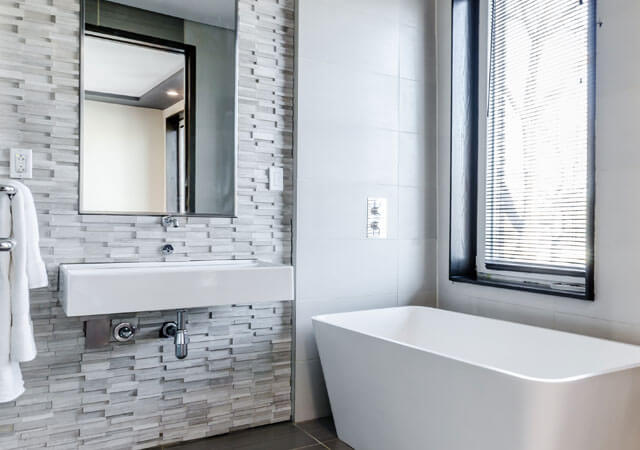
Finishing Touches
Grout Selection
The choice of grout can significantly impact the overall appearance of your bathroom tiles. It’s essential to consider the desired contrast, durability, and ease of maintenance when selecting grout.
- For a seamless look, choose a grout colour that closely matches the tile. This will create a unified appearance and make the tiles blend together.
- To emphasise the tile pattern, opt for a contrasting grout colour. This can make the tilework stand out and add visual interest to the space.
It’s crucial to consider the grout type as well. Epoxy grout is highly resistant to stains and does not require sealing, making it a low-maintenance option. On the other hand, cement-based grout may need to be sealed regularly to protect it from moisture and staining.
Tile Edging
Proper tile edging can protect the tile edges, create a clean finish, and enhance the overall design of the bathroom. There are several options for finishing tile edges, as detailed below:
- Stone trims offer a natural and timeless finish. Stone trims can complement the tile material and create a luxurious finish. However, they can be more expensive compared to other options.
- Porcelain or ceramic trim tiles are a popular choice for their versatility and wide range of designs. They can seamlessly integrate with the rest of the tilework and provide a cohesive look.
- Plastic and metal trims are durable and budget-friendly alternatives. They come in various finishes, such as brushed nickel or chrome, and can add a modern touch to the bathroom.
In summary, carefully selecting grout and tile edging can significantly enhance the appearance of your bathroom tiles. It’s important to consider your design preferences, budget, and maintenance requirements to achieve the perfect finishing touches for your bathroom tile project.
Trending Bathroom Tile Ideas in Australia
With so many options available, it’s crucial to consider various factors such as size, colour, pattern, and texture to find the ideal tile that harmonises with your bathroom’s overall design.
One popular trend in bathroom tile designs is combining multiple styles to bring depth and dimension to the space. Incorporating built-in lighting can further enhance the visual appeal of the tiles, creating an inviting atmosphere in the bathroom. Don’t shy away from experimenting with bold colours and patterns; they can add a personal touch and make a statement in your design.
Here are some popular bathroom tile ideas that are always on-trend!
Mosaic Tile Pattern
Mosaic tile patterns have gained popularity in Australian bathrooms due to their versatile, timeless and visually appealing nature. These patterns create a sense of unique and customised art in the bathroom, making them a favourite among homeowners. Mosaic tiles come in various shapes, sizes, textures, and colours, giving designers and homeowners endless possibilities to express their creativity. Some popular mosaic tile styles include geometric shapes, abstract patterns, and contemporary lines.
Subway Bathroom Tiles
Subway tiles are a classic choice for bathrooms, and they continue to be a popular trend in Australia. These tiles offer a clean, simple, and minimalist design that can fit any bathroom style. Traditionally, subway tiles were used in white, but nowadays, designers and homeowners are experimenting with various colours, sizes and patterns. For a more modern look, consider using vertical stripes with two shades, such as white and blue-grey.
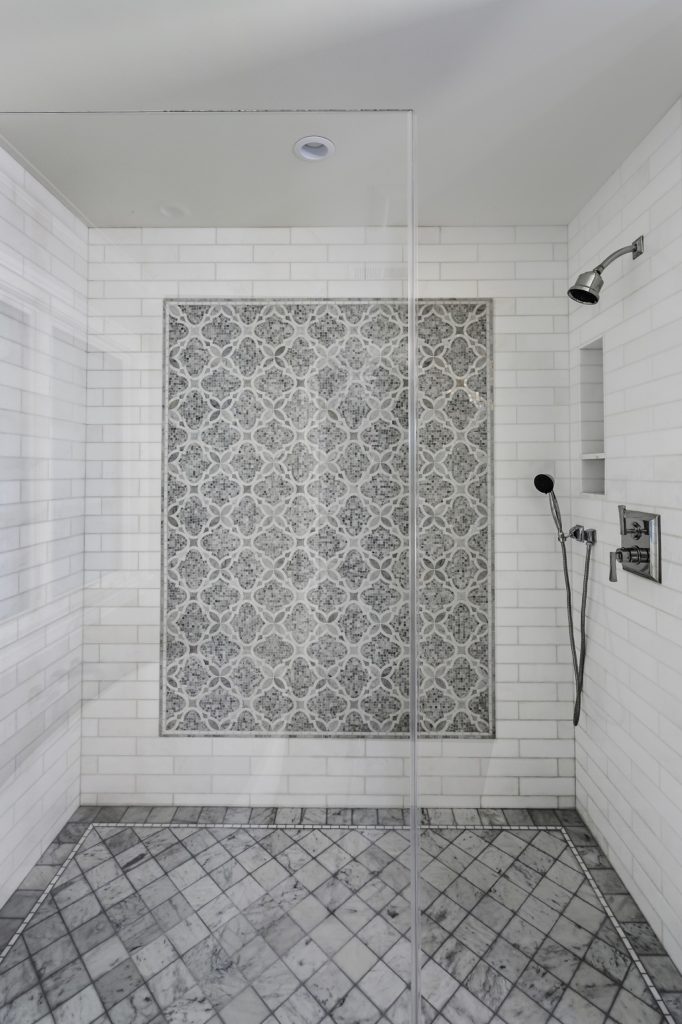
Modern Terrazzo Tiles
Terrazzo tiles bring a fresh, contemporary and inviting look to Australian bathrooms. With their unique speckled appearance and various aggregate sizes, colours, and materials, terrazzo tiles create a polished, elegant aesthetic. Modern terrazzo tiles have versatile applications, from floor and wall coverings to countertops and bathroom accessories. They can be used to create striking accents and are also known for their durability, making them a perfect choice for high-traffic areas.
Remember to balance the choice of tiles with other elements in your bathroom, such as fixtures and fittings, to create a harmonious and cohesive design.
Key Takeaways
- Bathroom tile renovations offer a wide range of material options like porcelain, ceramic, marble, and glass, each with unique benefits.
- Consider tile size and color to enhance the space's appearance, using larger tiles for small bathrooms to create a spacious feel.
- Maintenance varies by material, with porcelain and ceramic requiring less, and natural stone needing more care.
- Design options range from classic to modern, with layout patterns like straight lay, grid, herringbone, and chevron adding visual interest.
- Final touches such as grout selection and tile edging significantly impact the overall look.
Looking for Reliable Bathroom Renovations?
At Hunter Bathroom Renovations, our specialists will assist you in many ways, from finding the right paint to professional paint application. We ensure expert bathroom remodelling and design for all types of properties, including many other services.
Contact us or get a quick estimate.
Share
Jarrod Adnum
Jarrod Adnum is the founder of Hunter Bathroom Renovations. He is proud to lead an experienced team and support staff that are experts in their field. All staff ensure you are getting the best solutions and service for your bathroom.

